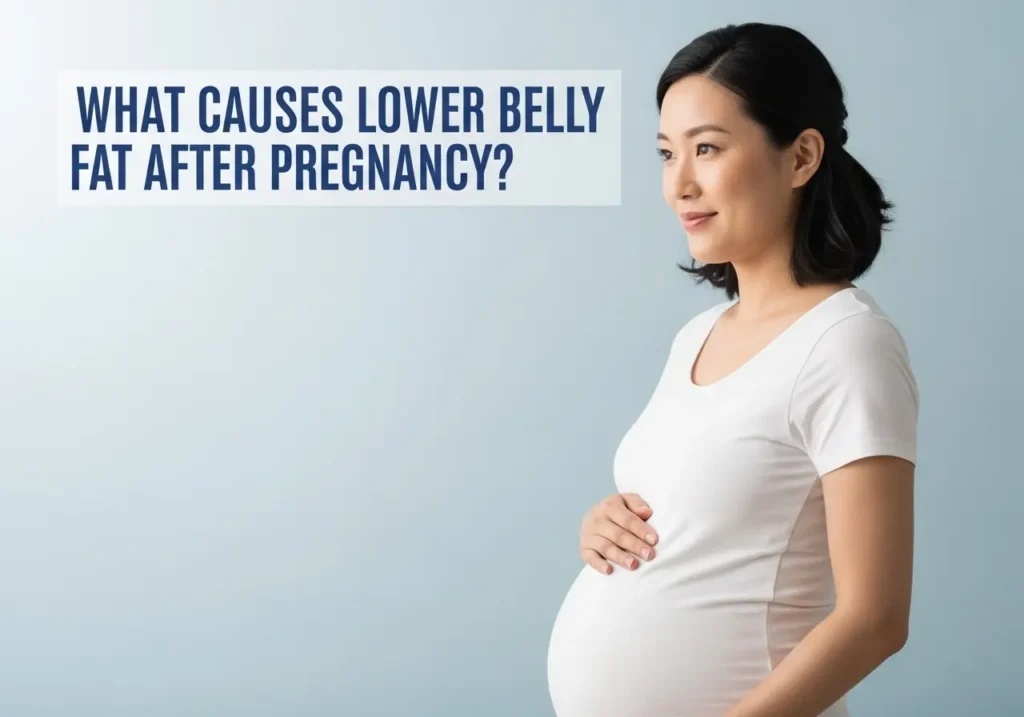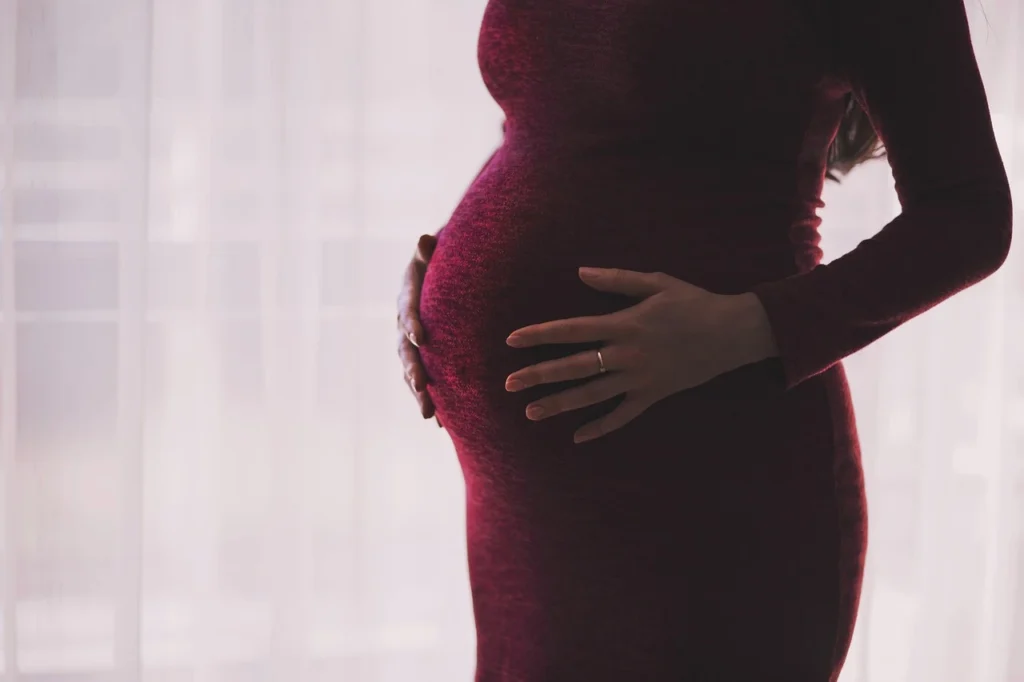Struggling with lower belly fat after pregnancy is a common problem, but not many people talk about it openly. The body undergoes numerous changes after delivery, so it’s completely normal to have a slight “pouch” or lower fat. But this fat can seem a little frustrating as you try to regain your strength, confidence, and pre-pregnancy shape. If you’re feeling stuck, you’re not alone. In this post, we’ll talk about why lower belly fat becomes stubborn after pregnancy and what realistic and healthy steps you can take to get long-term results.
Struggling with lower belly fat after pregnancy?

Lower belly fat after pregnancy is a common problem, although it can cause you many problems in the long term. For some time after pregnancy this lower abdominal fat can be very helpful for you and your baby as it provides energy and nutrition for the baby during breastfeeding and also helps you in recovery. After delivery, new moms have to face fatigue, lack of sleep, and stress, which increases the cortisol hormone, which causes an increase in belly fat. Due to a lack of time and fatigue, one does not get time to exercise, and unhealthy food choices also contribute to fat gain. Postpartum metabolism also slows down, and if your genetics have a tendency to store belly fat, it can become even tougher. For all these reasons, lower belly fat may seem stubborn, but with a healthy diet, core strengthening exercises, and patience, it can be gradually reduced.
What causes lower belly fat after pregnancy?

There can be many reasons for an increase in lower belly fat after pregnancy. First of all, hormonal changes slow down the metabolism and lead to more fat getting stored, especially around the tummy. The abdominal muscles that separate during pregnancy (called diastasis recti) can make the belly appear a little bloated or pouch-like even after delivery. Mothers often do not remain active while taking care of the newborn, which leads to a sedentary lifestyle. Emotional eating increases due to external stress, lack of sleep, and emotional ups and downs. When stress increases, the cortisol hormone also increases, which further increases the belly fat.
How long does it take to lose belly fat after pregnancy?
Reducing lower belly fat after giving birth can take anywhere from six to twelve months. Several factors play a role in how quickly or slowly this happens.
- Your pre-pregnancy weight
- How much weight did you gain during pregnancy (excluding the baby’s weight)
- Your diet and level of physical activity
- Your metabolism, whether it’s fast or slow
- You’re breastfeeding or not
Right after delivery, you typically lose about 10–15 pounds. This includes the weight of the baby, placenta, and fluids. In the first 6 weeks, your uterus gradually starts shrinking back to its normal size. If you’re breastfeeding, it may help with reducing lower belly fat, but keep in mind, fat loss happens throughout the body, not just one area.
- After 6 weeks, with your doctor’s approval, you can begin light exercises paired with a balanced, nutritious diet.
- 3 to 6 months: Regular healthy eating and workouts make a noticeable difference.
- 6 to 12 months: You can reduce belly fat and tone it with consistent efforts.
6 Powerful tips to get rid of lower belly fat after pregnancy

Add a balanced diet
For optimal postpartum recovery and reduction of abdominal fat, prioritize a diet rich in high-quality protein, dietary fiber, and unsaturated fats. Eliminate ultra-processed foods, which are often high in refined sugars and trans fats, as they contribute to inflammation and fat accumulation. Instead, incorporate nutrient-dense options such as leafy green vegetables, eggs (a complete protein source), and nuts, which support metabolic function, satiety, and hormonal balance.
Take care of hydration
Almost 60 to 70 percent of the body is made up of water, so it is very important to keep the body hydrated. Drinking less water can cause dizziness, constipation, kidney stones, and many other problems. So it is important to drink 2.5 to 3.5 liters of water (8-12 glasses) daily.
Breastfeeding will help
Breastfeeding helps a little in losing belly fat. It can help in weight loss, but this alone is not enough. When you breastfeed, your body burns extra calories because energy is needed to make milk. Approximately 300-500 extra calories can be burned in a day, which can help in weight loss.
Start with light exercise
It is important to do safe and effective exercises to reduce lower belly fat after pregnancy, but you should consult a doctor before doing this because the body takes time to recover after delivery. Here are some exercises that can help with lower belly fat loss when you are physically ready:
1. Pelvic Tilts
2. Kegel Exercises
3. Modified Plank
4. Bridge Exercise
5. Walking and Light Cardio
6. Diaphragmatic Breathing
Reduce stress
Stress increases the cortisol hormone, which stores fat. Manage stress with meditation, deep breathing, or light stretching.
Get enough sleep
Sleep is tough for a new mom, but take a rest whenever you get a chance. Less sleep slows down metabolism and increases cravings.
Foods that help reduce belly fat postpartum
Below is a list of 20 foods that can help reduce lower belly fat after pregnancy
| Food | Key Nutrients | How It Helps Belly Fat Loss |
|---|---|---|
| Avocados | Healthy Fats, Fiber, Potassium | Boosts satiety, reduces belly bloat |
| Greek Yogurt | Protein, Probiotics, Calcium | Builds lean muscle, improves gut health |
| Blueberries | Antioxidants, Fiber, Vitamin C | Reduces inflammation, supports metabolism |
| Strawberries | Fiber, Antioxidants, Vitamin C | Curbs appetite, promotes fat burning |
| Raspberries | Fiber, Manganese, Antioxidants | Controls hunger, boosts metabolism |
| Spinach | Iron, Fiber, Magnesium | Low-calorie, nutrient-dense, controls cravings |
| Kale | Fiber, Vitamin K, Antioxidants | Detoxifies the body, reduces bloating |
| Arugula | Fiber, Calcium, Vitamin K | Low-calorie leafy green for volume eating |
| Salmon | Omega-3s, Protein, B Vitamins | Reduces inflammation, builds lean mass |
| Eggs | Protein, Choline, Healthy Fats | Keeps you full longer, supports fat metabolism |
| Quinoa | Protein, Fiber, Iron | Plant-based protein for muscle building |
| Sweet Potatoes | Fiber, Beta-carotene, Potassium | Fights insulin resistance, high satiety |
| Almonds | Healthy Fats, Protein, Vitamin E | Reduces hunger, promotes fat burn |
| Chia Seeds | Fiber, Omega-3s, Protein | Expands in stomach, suppresses appetite |
| Oats | Soluble Fiber (beta-glucan), Iron | Balances blood sugar, long-lasting energy |
| Broccoli | Fiber, Calcium, Vitamin C | Fights belly fat, high in fiber |
| Chicken Breast | Lean Protein, B Vitamins | Builds muscle, boosts metabolism |
| Apples | Fiber (Pectin), Antioxidants | Promotes fullness, aids digestion |
| Lentils | Plant Protein, Iron, Fiber | Stabilizes blood sugar, protein-rich |
| Bell Peppers | Vitamin C, Fiber, Antioxidants | Low-calorie, speeds up fat oxidation |
Common mistakes to avoid

Jumping Into Intense Workouts Too Soon: Your body needs time to heal. Starting high-impact exercises without medical clearance can do more harm than good.
Focusing Only on Crunches: Spot reduction doesn’t work. Strengthening the entire core, especially deep core muscles, is more effective.
Skipping Meals or Crash Dieting: Undereating can slow your metabolism and affect your energy, especially if you’re breastfeeding.
Not Getting Enough Sleep: Lack of sleep increases cortisol, a stress hormone that contributes to belly fat.
Ignoring the Role of Nutrition: Exercise alone isn’t enough. Clean, balanced eating is crucial for fat loss.
Comparing Your Progress to Others: Every postpartum journey is unique. Comparing can lead to frustration and unhealthy habits.
Neglecting Hydration: Dehydration slows down metabolism and can increase bloating.
Not Managing Stress: Emotional stress can lead to overeating and increased belly fat due to hormone imbalance.
Over-Relying on the Scale: Scale weight doesn’t show fat vs. muscle. Focus on how your clothes fit and how you feel.
Avoiding Strength Training: Many women stick only to cardio, but strength training helps burn more fat and tone your body.
Lack of Support or Guidance: Trying to do it all alone can be overwhelming. Joining a mom group or working with a postpartum fitness coach helps with motivation and accountability.
Conclusion
Losing lower belly fat after pregnancy isn’t about chasing perfection—it’s about healing, rebuilding strength, and nourishing both your body and your mind. Remember, your body just did something incredible, and it deserves patience, care, and respect.
As you move forward, choose sustainable habits over quick fixes. Focus on real, whole foods, gentle movement, and listening to your body’s needs. Avoid plastic-packed processed snacks and instead embrace fresh, locally sourced produce whenever possible. By prioritizing your health, you also contribute to a healthier planet.
Whether you’re breastfeeding, walking in nature with your baby, or prepping clean meals at home, every small choice adds up—not just for your belly, but for your future and your family’s well-being.
For more natural and effective ways to support your journey, check out this guide on how to lose belly fat naturally at home
Take your time. Be kind to yourself. And remember progress is progress, no matter how slow.

